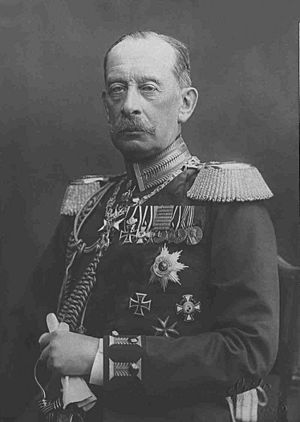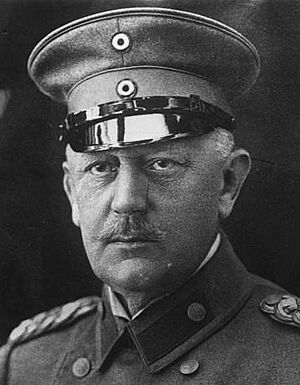Schlieffen Plan facts for kids
Quick facts for kids Schlieffen Plan |
|
|---|---|
| Operational scope | Offensive strategy |
| Planned | 1905–1906 and 1906–1914 |
| Planned by | Alfred von Schlieffen Helmuth von Moltke the Younger |
| Objective | disputed |
| Date | 7 August 1914 |
| Executed by | Moltke |
| Outcome | disputed |
| Casualties | c. 305,000 |

The Schlieffen Plan was a big military idea for the German army. It was created by Count Alfred von Schlieffen in 1905. He was a top German general. The plan was designed for a possible war against France. Germany and its allies, Austria-Hungary and Italy, would fight France.
The main idea was for Germany to quickly attack France. They planned to invade France by going through Belgium. The goal was to defeat France very fast, within a few months. This would allow Germany to then focus on other enemies.
Schlieffen retired in 1906. Eight years later, in August 1914, World War I began. German military leaders decided to use Schlieffen's old plan. They thought it would work just as he had imagined. However, the world had changed a lot in those eight years. The plan was not ready for the new conditions of the war.
What Was the Schlieffen Plan?
The Schlieffen Plan was a strategy for a two-front war. Germany feared fighting both France and Russia at the same time. The plan aimed to avoid this. It focused on defeating France quickly first. Then, German forces could move to fight Russia.
The plan involved a strong, fast attack. German armies would sweep through Belgium. They would then turn south into France. This quick move aimed to capture Paris and force France to surrender.
Why the Plan Didn't Work
When World War I started, General Helmuth von Moltke the Younger was in charge. He changed parts of Schlieffen's original plan. Moltke did not have enough soldiers to carry out the plan perfectly. Despite this, he still attacked France through Belgium.
Moltke believed that attacking was always better than defending. He thought the Russo-Japanese War proved this. In that war, Japan often attacked and won. So, Moltke chose to attack, even with fewer men.
Schlieffen's View on Defense
Interestingly, Schlieffen himself thought defending was often better. He said that soldiers defending a place could get there faster by train. Attackers had to walk, which was slower. This meant defenders could usually gather enough men to stop an attack.
Schlieffen also knew that new weapons helped defenders a lot. Things like trenches, machine guns, and barbed wire made it very hard for attackers. He was right. In World War I, defending was usually stronger. This changed only when attackers used huge amounts of artillery to help their infantry.
A Similar Idea in World War II
A plan similar to Schlieffen's was used later in World War II. This happened when Hitler's generals, Erich von Manstein and Heinz Guderian, invaded France. In that war, Germany attacked Belgium and the Netherlands.
France expected Germany to attack mostly through northern Belgium again. So, France sent most of its soldiers there. But Germany surprised them. German troops attacked mainly through southern Belgium. They marched quickly to the sea. This move trapped a large part of the French Army in northern Belgium.
The trapped French soldiers ran out of food and supplies. They had to surrender. France tried to keep fighting but was too weak. Soon after, France surrendered. While the World War II invasion was successful for Germany, the original Schlieffen Plan in World War I did not succeed.
Images for kids
-
Francs-tireurs in the Vosges during the Franco-Prussian War. -
"Western Front 1914; Schlieffen Plan of 1905. French Plan XVII" (USMA) "...a mishmash...." and "An armchair strategist's dream....", according to Terence Zuber (2011)
See also
 In Spanish: Plan Schlieffen para niños
In Spanish: Plan Schlieffen para niños







